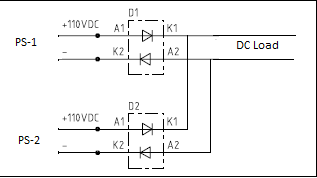Dear Team,
We have two power supply's 110VDC connected in parallel to each other. Power diodes are being used in both 110VDC power supply's. I can understand the use of diode in Positive supply, it can block the reverse current flow in other power source if one of Power supply voltage get drop or failed. But what is the sue of diode in negative supply of 110vdc. Pl refer the attached screen shot & share your valuable comments.
